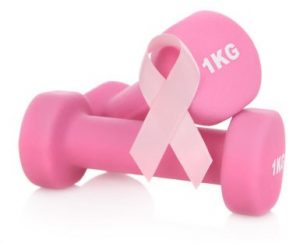It is estimated that in Australia 1 in 8 females and 1 in 668 males will be diagnosed with breast cancer by the time they are 85, that is a population total of 1 in 15 people. The good news is that survival rates are improving with the chance of surviving at least 5 years after receiving a diagnosis now being 92%. Like many other conditions, exercise can be a protective factor in the prevention of breast cancer, and it can also be used as part of an effective treatment regime once diagnosed.
Risk Factors
There are many risk factors of breast cancer which can be broken into two categories: modifiable and non-modifiable. Modifiable meaning that these risk factors can be addressed, while non-modifiable risk factors are those that are uncontrollable such as family history. Below are some examples:
| Modifiable Risk Factors | Non-modifiable Risk Factors |
| Sedentary lifestyle | Family history of breast or ovarian cancer |
| Obesity | Age |
| Hormone replacement | Genetic mutations |
| Reproductive history- breastfeeding | Previous cancer diagnosis or cancer treatments |
| Alcohol consumption | Composition of breast tissue |
| Reproductive history- early menstruation or late onset menopause results in prolonged exposure to hormones | |
| Exposure to certain drugs |
There are many considerations your Exercise Physiologist will look into before beginning to develop a program suitable to you. Some of these may include:
- Type of breast cancer
- Type of cancer treatment: surgery, chemotherapy, radiation, hormone therapies or targeted drug therapies
- Side effects from treatment
- Lymphoedema
- Lymph node removal
Exercise and the prevention of Breast Cancer
While there is still a lot of research being done in this area, exercise can help to reduce the risk of a breast cancer diagnosis by addressing some of the risk factors on the modifiable list. Being physically active sees a reduction in the risk of breast cancer as well as maintaining a healthy body composition. There has also been specific research into how exercise can impact the pathophysiology of breast cancer. There have been studies that suggest that exercise can help to lower sex hormones and growth factors associated with disease progression and preventing high levels of insulin, which has also been shown to impact disease progression. Exercise can also help to reduce systemic inflammation and improve the immune system response.
Exercise and the treatment of Breast Cancer
There are many benefits to exercising throughout and post-cancer treatment. These can include:
- Reduced symptoms of cancer related fatigue
- Increase muscle mass and bone mineral density, both of which can be impacted by the cancer itself and cancer treatments
- Improved shoulder mobility after undergoing surgery or if experiencing symptoms of lymphoedema or cording
- Reduce the impact of peripheral neuropathy
- Improved capacity to perform activities of daily living
- Improved mental health and mood, reduced risk of symptoms of anxiety or depression
- Reduced cardiovascular risk
Exercise can also prevent the risk of all-cause mortality or mortality because of breast cancer meaning those who have remained active have been shown to live longer past the time of their diagnosis. Being physically active can also reduce the risk of a recurrent diagnosis of breast cancer or other cancers.
What type of exercise is best?
- Aerobic and resistance exercise: there have been many modes of exercise studies in the treatment of breast cancer including home- or gym-based resistance exercise, Pilates, walking, cycling, water-based exercise, and circuit training. A combination of aerobic and resistance exercise is recommended to achieve the greatest benefit
- Moderate intensity exercise is recommended for those with breast cancer. If you have not been previously exercising, start with low intensity activity and build up. For those who are exercising regularly, high intensity exercise is safe to perform when prescribed appropriately
- For those with breast cancer it is recommended they work up to 150 minutes of moderate intensity exercise per week, this may start with as little as 10-minute bouts of activity. It is recommended that this should include at least 2 days of resistance training per week. There is a dose-response trend wherein accumulating up to 300 minutes of moderate intensity exercise may see further health benefits.
Vision currently has two Conquer Cancer classes on Tuesday from 7-7:30am and Friday from 9-9:30am predominantly for women. We also work closely with Hope Horizons, an organization whose goal it is to improve access to allied health professionals for those living with cancer in the Toowoomba region.




